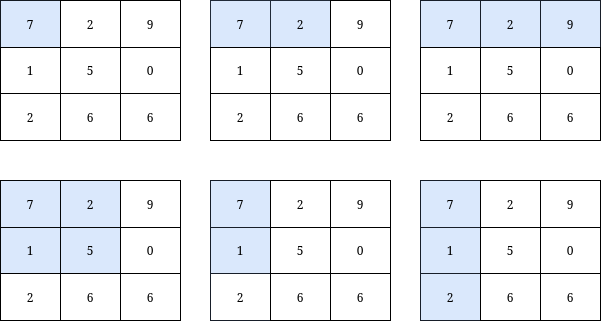| comments | difficulty | edit_url | rating | source | tags | |||
|---|---|---|---|---|---|---|---|---|
true |
Medium |
1498 |
Weekly Contest 387 Q2 |
|
You are given a 0-indexed integer matrix grid and an integer k.
Return the number of submatrices that contain the top-left element of the grid, and have a sum less than or equal to k.
Example 1:
Input: grid = [[7,6,3],[6,6,1]], k = 18 Output: 4 Explanation: There are only 4 submatrices, shown in the image above, that contain the top-left element of grid, and have a sum less than or equal to 18.
Example 2:
Input: grid = [[7,2,9],[1,5,0],[2,6,6]], k = 20 Output: 6 Explanation: There are only 6 submatrices, shown in the image above, that contain the top-left element of grid, and have a sum less than or equal to 20.
Constraints:
m == grid.lengthn == grid[i].length1 <= n, m <= 10000 <= grid[i][j] <= 10001 <= k <= 109
The problem is actually asking for the number of prefix submatrices in a two-dimensional matrix whose sum is less than or equal to
The calculation formula for the two-dimensional prefix sum is:
The time complexity is
class Solution:
def countSubmatrices(self, grid: List[List[int]], k: int) -> int:
s = [[0] * (len(grid[0]) + 1) for _ in range(len(grid) + 1)]
ans = 0
for i, row in enumerate(grid, 1):
for j, x in enumerate(row, 1):
s[i][j] = s[i - 1][j] + s[i][j - 1] - s[i - 1][j - 1] + x
ans += s[i][j] <= k
return ansclass Solution {
public int countSubmatrices(int[][] grid, int k) {
int m = grid.length, n = grid[0].length;
int[][] s = new int[m + 1][n + 1];
int ans = 0;
for (int i = 1; i <= m; ++i) {
for (int j = 1; j <= n; ++j) {
s[i][j] = s[i - 1][j] + s[i][j - 1] - s[i - 1][j - 1] + grid[i - 1][j - 1];
if (s[i][j] <= k) {
++ans;
}
}
}
return ans;
}
}class Solution {
public:
int countSubmatrices(vector<vector<int>>& grid, int k) {
int m = grid.size(), n = grid[0].size();
int s[m + 1][n + 1];
memset(s, 0, sizeof(s));
int ans = 0;
for (int i = 1; i <= m; ++i) {
for (int j = 1; j <= n; ++j) {
s[i][j] = s[i - 1][j] + s[i][j - 1] - s[i - 1][j - 1] + grid[i - 1][j - 1];
if (s[i][j] <= k) {
++ans;
}
}
}
return ans;
}
};func countSubmatrices(grid [][]int, k int) (ans int) {
s := make([][]int, len(grid)+1)
for i := range s {
s[i] = make([]int, len(grid[0])+1)
}
for i, row := range grid {
for j, x := range row {
s[i+1][j+1] = s[i+1][j] + s[i][j+1] - s[i][j] + x
if s[i+1][j+1] <= k {
ans++
}
}
}
return
}function countSubmatrices(grid: number[][], k: number): number {
const m = grid.length;
const n = grid[0].length;
const s: number[][] = Array.from({ length: m + 1 }, () => Array(n + 1).fill(0));
let ans: number = 0;
for (let i = 1; i <= m; ++i) {
for (let j = 1; j <= n; ++j) {
s[i][j] = s[i - 1][j] + s[i][j - 1] - s[i - 1][j - 1] + grid[i - 1][j - 1];
if (s[i][j] <= k) {
++ans;
}
}
}
return ans;
}
